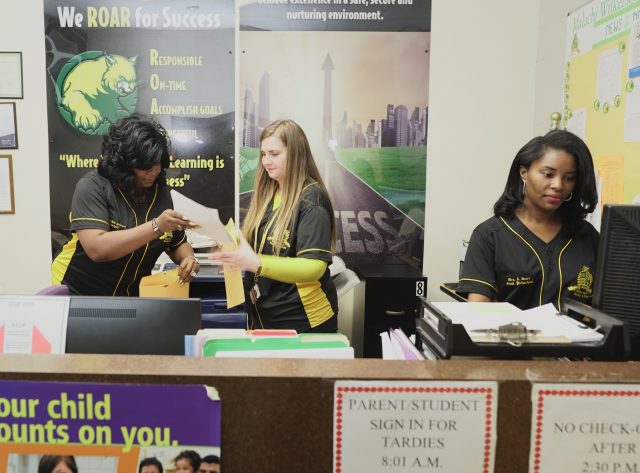
By Erica Wright
The Birmingham Times
Students may not be in classrooms as the spring semester winds down, but that doesn’t mean educators like Wilkerson Middle School Principal Davida Johnson aren’t engaging the learners.
The new normal for all amid the global COVID-19 health crisis means making major adjustments—and it’s no different at Wilkerson Middle.
“Prior to this pandemic, we already had protocols and procedures in place to ensure that teachers stayed on course with the standards,” said Johnson, who has been the school’s principal since 2015.
“[Now] teachers are using technology to engage students outside of the school using a variety of platforms,” including Schoology and Google Classroom, as well as communicating with parents through Class Dojo and Remind One-on-One, she added.
Class Dojo helps parents, teachers, and students build classroom communities online. Remind One-on-One is a communication platform that helps schools and districts reach out to and connect with families.
Even with these tools on hand, administrators like Johnson face another challenge posed by the COVID-19 shutdown: how to ensure that students don’t fall behind going into the summer months. There’s often an achievement gap for students during the summer, but that gap will now widen with students away from classes since March, when schools closed, and not returning until the fall.
Johnson said she and her team are already working to make sure that does not happen.
“We have weekly Zoom meetings [with] faculty and grade-level [proof of concept (POC)] meetings, during which we focus on how all students are being engaged and the response to engagement, as well as the contact teachers have made with parents and if there are any concerns,” said Johnson.
Emma Courington, a seventh-grade math teacher who is in her second year of teaching at Wilkerson, takes several steps to ensure students don’t fall behind.
“I make sure my assignments are extra-engaging,” she said. “I also make sure everything I do is standards based, so they’re not just doing math from the previous year but also doing the seventh-grade core curriculum that will best prepare them for eighth grade.”
Courington also has set up a competition where she calculates the points students get when doing assignments, showcases who is doing well, and gives feedback.
“It’s been working because they have been very engaged during Zoom classes with me and really showing up,” she said. “I’m really impressed with my students and how they have risen up and are making the best of the current situation.”
Engagement
Less than 10 percent of the 300 students at Wilkerson do not have access to technology at home, so instructors have set up bins outside the school with work packets for those without technology.
“It’s important for those students who don’t have access to technology because they are still able to learn and complete their coursework and stay on track,” said Johnson.
The bins are placed outside the school and separated by grade level and subjects—a sixth-grade math bin or an eighth grade English bin, for instance. Students or their parents can come by once a week to pick up or drop off the packets.
Both online and with packets, the students at Wilkerson are kept occupied.
“Working online, I’ve been able to move my standards for teaching there,” said Courington. “It’s important that we give students choices for how they can learn and grow during this time, so I gave them choices of nine different assignments to complete; they have to choose three and then submit them to me [online].”
Assignments include completing daily worksheets and Math Talk, through which students tutor a friend, solve problems, and explain the steps they take to solve the problems.
Student Response
The transition to distance learning has been easier for the students than it has for some of the teachers because “[students] are accustomed to using game systems, their cell phones, computers …,” said Wilkerson Assistant Principal Aulundria Grace. “It wasn’t so much the children we had to worry about, but the schools that needed to catch up because the [students] are already familiar with technology and how to use it.”
Some students prefer learning in the classroom, and some prefer online learning. Overall, students are still doing well, said Grace, adding that teachers have to keep pace by being responsible.
“We’ve created a teacher accountability log, so we know exactly which parents and students are contacted, when they are contacted, and what it was concerning,” said Grace. “Teachers highlight the standards they’re covering and the instructional approach they are using. [Johnson] and I, as administrators, review that information and bring it back to our faculty meetings to determine the effectiveness of those strategies.”
One of the positives of distance learning is that parents now have a greater role in helping their children with school, Johnson said.
“Parents are now monitoring student progress on a daily basis to make sure they are engaging in learning activities. Most parents have been doing that,” she explained. “When parents have concerns, they can contact [any of us]—I have given them my personal phone number and teachers have given out their numbers. We’ve provided a variety of ways to make sure they are able to connect with us if they need additional support.”










